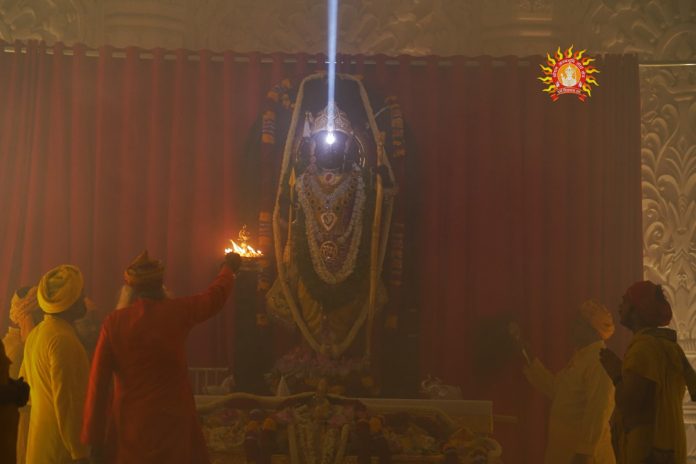Ayodhya: At noon on Wednesday (April 17), a three-minute Surya Tilak ceremony took place at Ayodhya‘s newly-constructed Ram temple, commemorating Ram Navami.
During this ritual, a beam of sunlight was projected onto the forehead of Lord Ram’s idol, facilitated by a unique mirror-lens arrangement devised by astronomers at the Indian Institute of Astrophysics (IIA), Bengaluru. The installation of this arrangement in the temple was executed by a team from the Central Building Research Institute, Roorkee.
असुर नाग खग नर मुनि देवा।
— Shri Ram Janmbhoomi Teerth Kshetra (@ShriRamTeerth) April 17, 2024
आइ करहिं रघुनायक सेवा।।
जन्म महोत्सव रचहिं सुजाना।
करहिं राम कल कीरति गाना।।
असुर-नाग, पक्षी, मनुष्य, मुनि और देवता सब अयोध्या में आकर रघुनाथ जी की सेवा करते हैं। विद्वान जन प्रभु के जन्म का महोत्सव मनाते हैं और श्री राम की सुंदर कीर्ति का गान करते हैं।… pic.twitter.com/joNulZeOKD
We elucidate the scientific process behind Ram Lalla’s Surya Tilak:
Step 1: Prediction of Sun’s Position (Annually) Due to the variance between the Gregorian and Hindu calendars, the date of Ram Navami fluctuates yearly. The Indian Institute of Astrophysics (IIA) team, tasked with ensuring sunlight falls precisely on the idol’s forehead on Ram Navami, initially computes the Sun’s position for that particular day of the year.
Annapurni Subramaniam, Director of IIA, explained: “Our first challenge was estimating and forecasting the Sun’s position on a specific day in a given year.”
Step 2: Sun’s Ray Channelization Once the astronomers predict the Sun’s location, their subsequent objective is to direct the sunbeam onto the idol’s forehead for a set duration. The IIA team, devising the apparatus over three years, proposed a setup comprising four mirrors and four lenses for this purpose.
Subramaniam elaborated: “The initial mirror, responsible for receiving sunlight, must be angled along the sun rays’ path.”
The light undergoes reflection across three additional mirrors and passes through four lenses to attain the desired intensity, directed towards the idol’s forehead. This opto-mechanical system, akin to a periscope, necessitates adjustments to accommodate the annual variation in the Sun’s position relative to the first mirror. Hence, a 19-gear system was devised, coinciding with the Metonic cycle, ensuring system recalibration every 19 years.
Yet to Reach Final Configuration The apparatus, housed within a glass tube, extends from the temple’s third floor to the sanctum sanctorum, demanding precise handling and a controlled environment. The IIA team expresses concern about potential soot and dust accumulation, particularly on the final mirror within the sanctum sanctorum. Hence, the design permits access for cleaning if necessary.
Although the temple’s construction remains ongoing, a modified version of the system—comprising four mirrors and two lenses—was deployed from the second floor during the temple’s inaugural Ram Navami celebration on Wednesday.

